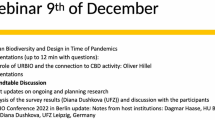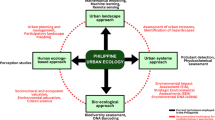Abstract
Urban ecological land planning is an important foundation and premise of urban ecosystem protection. Based on the structure of geosynclinal fold belt, the spatial allocation model of ecological land in the urban fringe of Xi’an city is designed. Taking the ecological land in the urban fringe of Xi’an city as an example, after analyzing the structure of geosynclinal fold belt in this area, the comprehensive index model of regional ecological effect based on the structure of geosynclinal fold belt is adopted to calculate the comprehensive index of ecological effect in the urban fringe of Xi’an city and obtain the ecological number in the urban fringe of Xi’an city. According to the ecological data, the paper constructs the spatial planning model of urban ecological land based on ant colony optimization algorithm and realizes the spatial allocation model design of ecological land in the urban fringe of Xi’an city based on geosynclinal fold belt structure. The results show that the edge space of Xi’an city based on geosynclinal fold belt structure is in good agreement with each other after the spatial allocation of ecological land in urban fringe area of Xi’an city by using the designed model, and the ecosystem service value is high, which provides some help for improving the urban ecosystem protection.


Similar content being viewed by others
References
Alembert AG, Urs SK, Amadou DK (2018) Multiple Ediacaran tectono-metamorphic events in the Adamawa-Yadé Domain of the Central Africa Fold Belt: insight from the zircon U-Pb LAM-ICP-MS geochronology of the metadiorite of Meiganga (Central Cameroon). Geol J 53:2955–2968
Drouineau H, Carter C, Rambonilaza M (2018) River continuity restoration and diadromous fishes: much more than an ecological issue. Environ Manag 61(4):1–16
Du XJ, Shao FJ, Sun RC (2019) Simulation study on eutrophication assessment of marine water. Comput Simul 36(5):377–380+460
El-Sabaawi RW (2017) How fishes can help us answer important questions about the ecological consequences of evolution. Copa 105(3):558–568
Gong YJ, Chen E, Zhang XL (2017) AntMapper: an ant colony-based map matching approach for trajectory-based applications. IEEE Trans Intell Transp Syst 19(2):390–401
Graeme S, Cumming TH, Morrison TP (2017) New directions for understanding the spatial resilience of social -Ecological systems. Ecosystems 20(1):649–664
Guido B, Diana DL, Valeria C (2018) Marine spatial planning using high-resolution synthetic aperture radar measurements. IEEE J Ocean Eng 43(3):586–594
Jarmo L, Jari O, Eero K (2017) Regional and vegetation-ecological patterns in northern boreal Flark fens of Finnish Lapland: analysis from a classic material. Ann Bot Fenn 54(1):179–195
Jie Q (2018) Research on civil architecture design based on BIM technology. Autom Instrum 22:19–20
Jing X, Peng P (2019) Urban-rural economic inequality and monetary policy from the ecological perspective: an empirical study based on china. EKOLOJI 28:1877–1883
Lark RM, Hamilton EM, Kaninga B (2017) Nested sampling and spatial analysis for reconnaissance investigations of soil: an example from agricultural land near mine tailings in Zambia. Eur J Soil Sci 68(5):605–620
Lin Y, Chen H, Lu W (2019) A DEA-based study on the environmental performance assessments of urban land use. EKOLOJI 28:1513–1519
Lucas S, Cristian VE, Catalina B (2017) Participatory, multi-criteria evaluation methods as a means to increase the legitimacy and sustainability of land use planning processes. The Case of the Chaco Region in Salta, Argentina. Environ Manag 59(2):307–324
Mathieu B, Craig R (2018) Mosquito traps for urban surveillance: collection efficacy and potential for use by citizen scientists. J Vector Ecol 43(1):98–103
Natália CL, Emili GB, Juliana DD (2018) Cumulative ecological effects of a Neotropical reservoir cascade across multiple assemblages. Hydrobiologia 819(4):77–91
Paolo V (2017) Urban spatial structure in OECD cities: is urban population decentralising or clustering? Urban spatial structure in OECD cities. Pap Reg Sci 97(4):376–389
Ramón AS, Javier LC (2017) Edge effect on bird nest predation in the fragmented caldén (Prosopis caldenia) forest of central Argentina: an experimental analysis. Ecol Res 32(2):129–134
Shengen L, Hang W, Ye D (2018) Forest conversion induces seasonal variation in microbial β-diversity: seasonal shifts in ecological processes. Environ Microbiol 20:111–123
Shou H, Wei LJ (2018) Design and research of battery charge and discharge control system. Chin J Power Sources 42(6):886–888+891
Sun JJ, Zhao Y, Wang S (2018) Improvement of SIFT feature matching algorithm based on image gradient information enhancement. J Jilin Univ 56(1):82–88
Wang CH, Han D (2017) An effective blind forensics detection scheme of median filtering image. J China Acad Electron Inf Technol 12(6):668–674
Wang Z, Deng X, Wang P (2017a) Ecological intercorrelation in urban-rural development: an eco-city of China. J Clean Prod 163(Supplement):28–41
Wang L, Yu ZW, Han Q (2017b) Multi-objective optimization based allocation of heterogeneous spatial crowdsourcing tasks. IEEE Trans Mob Comput 17(7):1637–1650
Xiao FL, Zhan ZH, Deng JD (2018) An energy efficient ant colony system for virtual machine placement in cloud computing. IEEE Trans Evol Comput 22(1):113–128
Yang Y, Zhang D, Meng Q (2017a) Stratified evolution of urban residential spatial structure in China through the transitional period: a case study of five categories of housings in Chengdu. Habitat Int 69(7):78–93
Yang Q, Chen WN, Yu ZT (2017b) Adaptive multimodal continuous ant colony optimization. IEEE Trans Evol Comput 21(2):191–205
Yao BZ, Chen C, Song XL (2019) Fresh seafood delivery routing problem using an improved ant colony optimization. Ann Oper Res 273:163–186
Zhang R, Wang J, Chen ZX (2018) Wireless digital communication technology for parallel DC-DC converter. J Power Supply 16(3):44–47
Acknowledgments
Comprehensive Measurement and Spatial Optimization of Urban Ecological Carrying Capacity in Xi’an city from the Perspective of Ecological Civilization (2014 D18).
Author information
Authors and Affiliations
Corresponding author
Additional information
This article is part of the Topical Collection on Geological Modeling and Geospatial Data Analysis
Rights and permissions
About this article
Cite this article
Zhao, D. Spatial allocation model of ecological land in the urban fringe of Xi’an City based on geosynclinal fold belt structure. Arab J Geosci 13, 764 (2020). https://doi.org/10.1007/s12517-020-05745-5
Received:
Accepted:
Published:
DOI: https://doi.org/10.1007/s12517-020-05745-5




